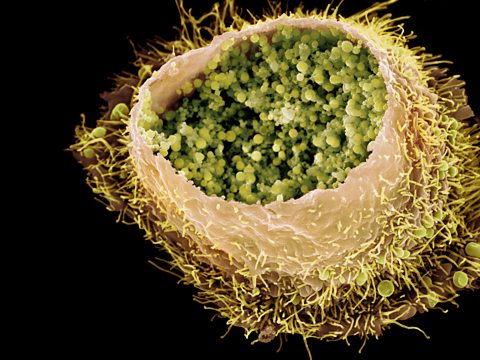Sexually-transmitted infections
Sexually transmitted infections (STIs) are passed from one person to another through sexual contact. This includes anal, oral or vaginal sex. There are more than 30 different pathogenMicroorganism that causes disease. that cause STIs. These include bacteriaSingle-celled microorganisms, some of which are pathogenic in humans, animals and plants. Singular is bacterium. like Chlamydia and virusAn ultramicroscopic infectious non-cellular organism that can replicate inside the cells of living hosts, with negative consequences. like HIVHuman Immunodeficiency Virus, a disease which damages cells in the immune system.. To reduce the spread of STIs people can abstain from sexual activity or use a barrier-type of contraceptionAny form of birth control used to prevent pregnancy. like a condom.
Chlamydia

Chlamydia is a sexually transmitted infection caused by a bacteriaSingle-celled microorganisms, some of which are pathogenic in humans, animals and plants. Singular is bacterium.. It is a common infection, especially amongst people under 25. The NHS recommends that people who are under 25 and sexually active have a Chlamydia test every year or if they change partner.
Chlamydia causes a burning pain when urinating and often forms a thick yellow or green dischargeGreen or yellow liquid containing pus that arises from an infection. from an infected person's penis or vagina. In women it can also cause bleeding between periods and men can develop swollen testicles.
If untreated, infection with Chlamydia can result in infertileNot being able to have children.. Like other bacterial infections, Chlamydia is treated by antibioticsSubstances that control the spread of bacteria in the body by killing them or stopping them reproducing..
HIV/AIDS
HIVHuman Immunodeficiency Virus, a disease which damages cells in the immune system. stands for human immunodeficiency virus. This infection is transmitted by body fluids, often during unprotected sex, but also through cuts and injecting drugs using unsterilized needles. Immediately after infection, people often suffer mild flu-like symptoms. These pass and for a period of time infected people might not know they are infected.
AIDSAcquired Immune Deficiency Syndrome â a disease of the human immune system caused by infection with Human Immunodeficiency Virus (HIV). stands for acquired immune deficiency syndrome. Months or years after the infection of the HIV virus, the virus may become active and start to attack the patientâs immune systemThe body's defence system against entry of any foreign body, including pathogens and agents such as pollen grains. The role of the immune system is to prevent disease.. HIV at this point has resulted in AIDS.
There is no cure for HIV /AIDS although many scientists are trying to find one. Currently, infected people are given antiviralsDrugs that prevent viruses replicating., which can significantly slow the development of AIDS.